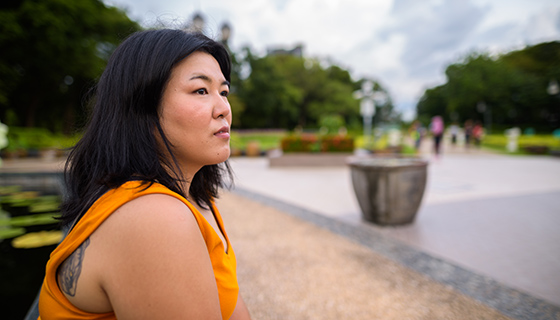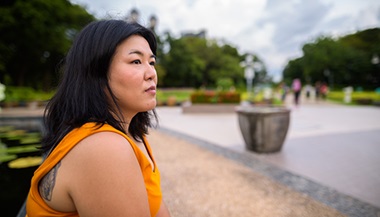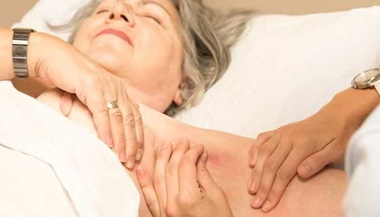Patient Story
Plastic Surgery for Lymphedema: Tiffany’s Story
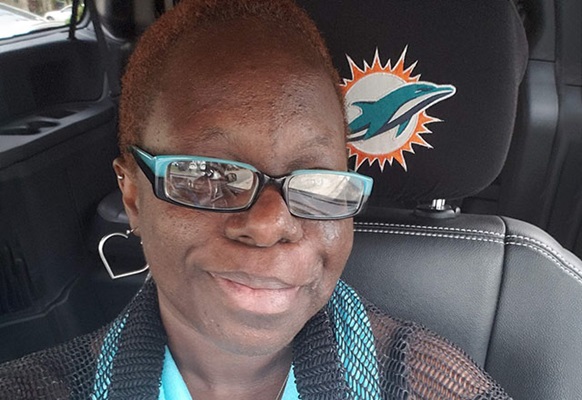
Patient Story Highlights
- Tiffany Howe had been living with progressively worsening lymphedema in her leg since birth.
- After researching several doctors and treatments, Tiffany underwent surgery at Johns Hopkins.
- Today she’s a more active mom and advocates for herself and others with lymphedema.
When Tiffany Howe was born with a club foot, she had to wear casts on her legs and feet to correct the problem. Even at that early age, doctors noticed a difference in Tiffany’s legs.
“One leg looked larger than the other,” Tiffany says.
The difference became more apparent as Tiffany grew up. “With puberty and all the changes associated with that, the leg started getting bigger. By the time I was getting ready for college, I had a hard time wearing pants and shoes.”
When she was 17, Tiffany was diagnosed with primary lymphedema.
Increased Swelling, Expensive Treatments
As a student at Norfolk State University in Virginia, Tiffany did her best to adapt to her new environment. Her doctor recommended weekly sessions of manual lymphatic drainage (MLD) and compression wraps, standard treatment for the condition.
But the treatments were expensive for a college student without insurance. Tiffany also underwent two liposuction surgeries to remove some of the pressure in her leg, but says the procedures made the swelling worse.
When she was 24, Tiffany gave birth to her daughter. “After my daughter was born, I had real trouble with my leg, and I had to stop working. I had no insurance and couldn't afford the compression garments, wrapping and MLD.”
Tiffany found another doctor who treated her with a surgical debulking procedure on her lower leg. “I responded well, and for a few years, I got my life back,” she says. But lymphedema is chronic, so although treatments can help, relief doesn’t always last. The skin on Tiffany’s leg began to break down, and chronic wounds leaked lymph fluid—a condition called lymphorrhea.
Doctors mentioned the possibility of amputating her leg if her situation continued to deteriorate.
I've never experienced a team like the one at Johns Hopkins. They take your feelings seriously.
Tiffany Howe
Taking Charge of Her Health
At that point, Tiffany sensed that dealing with her lymphedema would require her to do research, learn all she could, and advocate for herself. Another lymphedema patient she had met through her online outreach recommended the plastic and reconstructive surgeons at Johns Hopkins.
Tiffany found out how to get a referral, switched her insurance and got an interview.
“My first meeting with the doctors at Johns Hopkins was amazing,” Tiffany recalls. “My surgeon was patient. He didn’t rush me or make me feel ‘less-than’. And he didn’t insist on surgery right away; he looked at all the options. My situation was pretty advanced, and he consulted with others on his team to figure out the best way to treat me.”
A Caring and Compassionate Approach
Tiffany appreciated Johns Hopkins’ thorough approach to her case, the time her surgeon took to explain his recommendations to her and her family, and his accessibility. All of this made it easier for her to endure the weekly trips to Baltimore.
“I’ve never experienced a team like the one at Johns Hopkins. They take your feelings seriously.”
Primary lymphedema is rare, and even among those who live with the condition, only a few people have the massive, localized swelling that Tiffany was enduring.
But Tiffany made a commitment to herself and her health, and became a very good self-advocate, taking the time to understand the details and the risks of the procedures.
Together, she and her surgeon decided on surgical treatment.
Lymphedema Surgery
“Unfortunately, I wasn’t able to undergo surgery right away,” Tiffany says. Her blood levels of a protein called prealbumin were too low, and her surgeon was concerned she wouldn’t heal properly.
With guidance from her surgeon, Tiffany went on a diet to improve her nutrition and prepare her for her procedure.
Finally, in May 2018, Tiffany was ready for her first operation. The surgeon took out 40 pounds of fluid and tissue from her leg, performing a direct excision of the excess skin, fat and lymphatic fluid build-up. The goal was to make Tiffany’s affected leg as small as possible.
“I healed so well,” Tiffany notes. “My doctors at home were amazed.” After taking time to recover, Tiffany underwent another surgery in November and another in April 2019: three surgeries in all. Tiffany still wears her compression garments diligently to minimize swelling.
The surgery helped decrease the size of Tiffany’s thigh by 30 to 40%. Now that her legs are closer to the same size, it is easier for her to walk and get around.
An Active Mom and Lymphedema Advocate
“I have hit so many milestones already, and I know there are more to come,” Tiffany says.
March is lymphedema month, and in 2019 Tiffany took part in a lymphedema conference near her home base in York County, Virginia. She participated in a fashion show at that event, and was overjoyed to wear slacks for the first time in 15 years.
She says since her surgery, it’s easier to get into her van to drive, and she doesn’t require an extra seatbelt expander.
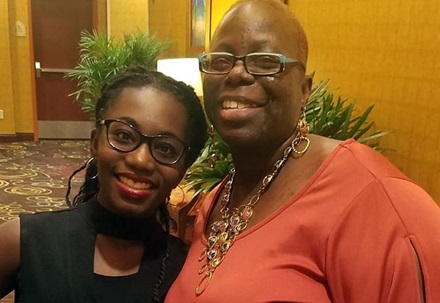
Most of all, Tiffany is glad to participate more in her daughter’s life. “I can chaperone her activities like the other parents. We took a bus trip with her chorus group, and I was able to ride in the seat and walk outdoors without dragging my leg behind me.”
Tiffany stays active in the lymphedema support communities, and says it feels great to give back.
“People get scared with this diagnosis,” she says, “but you can accomplish a lot when you stay on top of it, research insurance and treatment options and keep advocating for yourself.“
You’ll do fine.”


